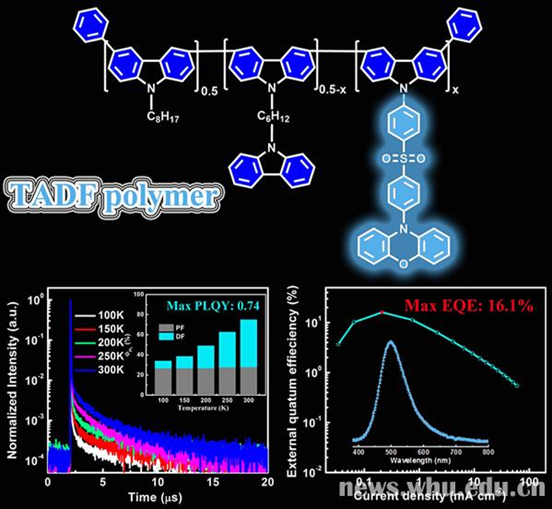Advanced Material, a top journal in field of chemistry and materials, has recently published the latest findings of Yang Chuluo, Professor of College of Chemistry and Molecular Science, and his team members. The paper, entitled inheriting the characteristics of TADF small molecule by side-chain engineering strategy so as to enable the bluish-green polymers with high PLQYs up to 74% and external quantum efficiency over 16% in light-emitting diodes fully presents their research fruits. It is co-authored by associate research fellow Xie Guohua and PhD candidate Luo Jiajia with Professor Yang Chuluo as the corresponding author.
Organic electroluminescent material research has been attracting more and more eyeballs with the release of the news that the Apple Inc will equip iPone 8 with OLED screen for the first time. Thermally activated delayed fluorescence (TADF) material, regarded as luminescent material of the third generation after the traditional fluorescent material and the phosphorescent materials, is becoming a hotspot in field of organic electroluminescent materials in the past two years.
By side-chain engineering strategy, Professor Yang Chuluo and his team finally composed a series of side-chain luminescent materials of polymers with high PLQYs based on previous design of unsymmetric fluorescence quantum efficiency small molecules entitled D1-A-D2. The molecular orbital distribution of this kind of material is almost identical with side chains of TADF it utilizes, and almost all the characteristics of small molecules are inherited into the polymers. The maximum fluorescence quantum efficiency of the material in toluene liquid is up to 74%, and the reverse gap crossing rate could reach 8.6 × 105 s-1. These two indexes mark an unprecedented level in the circle of polymer materials.
In order to further improve the efficiency of electroluminescence, the team has been trying to utilize small molecular materials with TADF whose efficiency come up to 100% as sensitizer. This strategy boost the fluorescence quantum efficiency up to 95%, and finally realized electroluminescent devices of TADF polymers sensitized by TADF small molecules for the first time. The EQE of this kind of devices could reach 16.1% under the practical brightness of 100 cd/m2, which has substantially break the record of former bluish-green polymers under the same brightness ever since. Noticeably, this research program received financial support from National Strategic of Advanced Electronic Materials, National Basic Research Program and Key Project of National Natural Science Foundation of China.

Rewritten by Zhang Qiyue
Edited by Shen Yuxi, Hu Sijia


